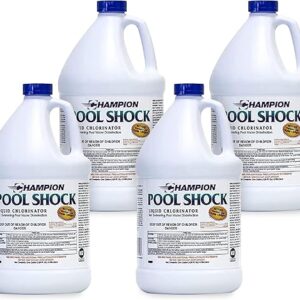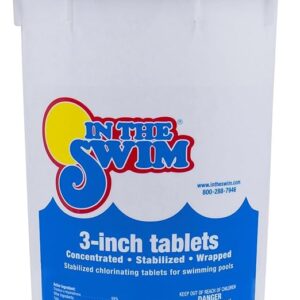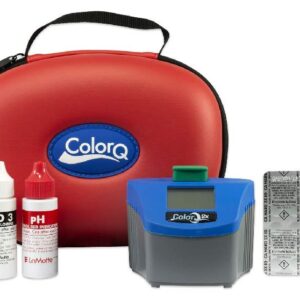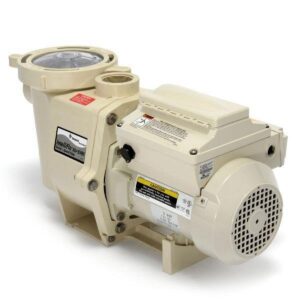How to Clear and Prevent Metal Stains in a Swimming Pool
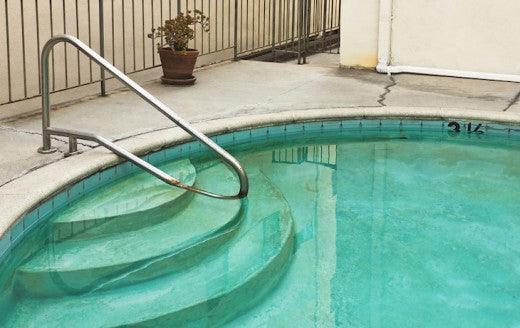
Why Swimming Pools Discolor After Chlorination
Swimming pool fill water sourced from the Well is always full of heavy metals such as Copper, Iron, Silver, Magnesium, or Manganese. These metals can also be found in some untreated tap water, and to avoid metal stains, it’s advisable to test your fill water for heavy metals and use a garden hose pre-filter if some heavy metals like copper and iron test positive, before using it in your pool or spa.
Most Loved Cordless Pool Cleaner: Aiper Scuba S1 Cordless Robotic Pool Vacuum Cleaner: Cleaning Schedule, Smart Navigation, Wall, Floor, & Waterline Cleaning, Suitable for all Pools Up to 1,600 sq.ft
When chlorine oxidizes heavy metals, it produces metal stains in a swimming pool. If your pool water has been changing color to green, brown, or black, especially after adding chlorine or when the pH is high, that is probably a metal stain.
It’s caused by heavy metals in pool water, commonly Copper, Iron, and Silver. The good news is that you can get rid of metal stains and prevent metal staining in the future.
The most common types of metals you can find in your pool water are Copper and Iron. However, silver, magnesium, and manganese may also be found in some pools, especially when using well water.
Copper metal will be oxidized by Chlorine or high pH, producing light green stains; Silver is oxidized, producing black stains; Iron is oxidized, producing brown or rusty stains; Manganese and Magnesium are oxidized, producing purple stains that can be seen on the walls, floor, liners, fiberglass, and sometimes on pool equipment.
However, it would be best to ensure your pool is affected by metal stains. Organic stains from algae, leaves, and other organic matter may cause stain colors similar to metal stains. This article is divided into three main parts:
- Test to determine the cause of stains(organic or inorganic stain)
- How to clear metal stains and
- Ways to prevent metal stains in the future
1.) Is it an Organic Stain or a Metal Stain?
If not careful, you might mistake Copper and Silver stains for green and black algae, respectively. Before starting treatment for metal stains, you need to be sure that you are dealing with metal stains (inorganic stains) caused by heavy metals such as Iron, Copper, and Silver or organic stains caused by algae, plants, leaves, and more.
1. Use Ascorbic Acid Test for Metal Stains
Doing this won’t take you 10 minutes. To determine whether it’s a metal or organic stain and properly treat it, use ascorbic acid powder (or vitamin C tablet) to test the stains.
Rub ascorbic acid in the affected area; if the stains come out or loosen after applying ascorbic acid, you are dealing with metal stains, not stains caused by algae or other organic matter.
2. Use the Chlorine Tablet (Trichlor) Test for Organic Stains
If you can’t find ascorbic acid to do the test, you can use a chlorine tablet (trichlor) to determine if it’s an organic stain. Place a chlorine tablet on the stain for a few minutes; if the stain lightens and clears, you are dealing with an organic stain, which you can remove by raising the free chlorine (FC) level to a given shock level, which can range from 10ppm going upwards.
3. Perform Overnight Chlorine Lose Test (OCLT).
Another test you can take to determine what you are dealing with is the Overnight Chlorine Loss Test(OCLT). The copper stain is light green but might look like green algae. To do the test, chlorinate your pool as required in the evening when the sun is gone and take the Free Chlorine(FC) reading both in the evening of chlorination and the following morning. If you lose 0-1ppm of FC, it’s not an organic stain but a metal stain; algae eat up lots of chlorine, and you will lose above 1ppm of FC overnight.
Related Products: 16000 BTU Heat Pump for Upto 5000 Gallons Above-ground Pools & Spas, Heater and Cooler with WiFi Timer, 120V
Raypak 399,000 BTU Natural Gas Pool Heater – Electric Ignition
2.) How to Clear Metal Stains in a Swimming Pool in Six Steps
When you are finally sure it’s metal staining, you can use ascorbic acid to remove the metal stains from your pool. Follow the guide below to clear metal stains using ascorbic acid.
Step 1: Lower FC Level to 0ppm
Reduce FC level to 0ppm. Reducing your FC is essential to avoid more metal stains while eliminating the stains. Also, chlorine will eat up most of your ascorbic acid, which should be used in clearing metal stains.
To lower your FC level, use a chlorine-neutralizing agent or drain and refill a portion of your pool water, or wait until FC gets 0 ppm naturally. However, waiting for the FC level to drop by itself will take time, and you will have to add polyquat 60 algaecide (non-metal algaecide) in your water to prevent algae while the FC level is at 0 ppm.
Step 2: Lower pH Level to 7.2
Ascorbic acid will be ineffective in pH above 7.2, so reducing your pH to 7.2 if higher than that is essential. High pH also causes metal stains, and you don’t want more stains while clearing the stains.
You can use pH minus or muriatic acid to lower pH, but remember, muriatic acid will lower your alkalinity, too, and you will have to balance your water when done.
Step 3: Put your Filter on Circulation
You need to put your filter on circulation to speed up the process by allowing water to move around the pool. This will also enable ascorbic acid to effectively clear the stains without letting some out of the pool through the filter.
Step 4: Add Correct Amount of Ascorbic Acid
Add 1 POUND of Ascorbic acid to every 10,000 GALLONS pool; if you have a 40k gallons pool, you will add 4 lbs or pounds to your pool, targeting most stains-affected areas.
Put the correct amount of ascorbic acid for your pool size in a cup and drop it down the sides around your pool. Let ascorbic acid circulate for 30 minutes and watch stains disappear slowly until you see no more stains.
If the stains are not all gone, add more ascorbic acid on the spots where you can still see traces of stains, and repeat until you see no more stains.
Step 5: Add Metal Sequestering Agent
When your pool is free of metal stains, remember that your water is still full of heavy metal compounds and will stain again when you add chlorine.
To avoid more metal stains, you need to add a metal sequestering agent. This chemical holds heavy metals like Iron and Copper together in a solution so that they don’t get oxidized by chlorine to produce metal stains.
Step 6: Put your Filter on FILTER and Balance your Water Chemistry
After clearing all the stains and adding a metal sequestering agent, put your filter on the Filter and leave your pool for 24 hours before adding anything. After 24 hours, you can start balancing chemicals.
Balance pH and TA Levels: Ascorbic acid, though not a strong acid, will lower your pH and total alkalinity (TA) slightly lower than you left them; however, the difference might be minimal. Test your pH and TA and make adjustments as appropriate.
If TA is balanced but you still need to raise the pH, use Borate to raise your pH without raising the TA level further, but don’t let pH go higher than 7.2 to keep metal stains in control.
Bring up Free Chlorine Level: After getting your pH and TA properly balanced, you can raise your FC level. I prefer you use liquid chlorine that will not increase your pH, Calcium, and Cyanuric acid levels caused by powder and tablet chlorine.
You need to add chlorine slowly while watching for traces of metal stains. First, raise your FC to 2 ppm. If you see no stains in 15 minutes, raise your free chlorine to the recommended level for your Cyanuric acid level in the water. Here is more on how to shock your swimming pool, whether saltwater or non-saltwater.
However, if you see stains while adding chlorine, stop adding more chlorine and make sure your pH is 7.2 before adding more metal sequestering agents to lift the stains. Don’t shock your pool for two weeks; leave ascorbic acid and metal sequestering agent to work fully.
After two weeks, your chlorine should hold easily since ascorbic acid has been used up without causing more stains. Remember to use metal sequestering agent treatment frequently as the manufacturer directs, usually doses of one week to one month to control metal stains.
Related Product: CHLORWORKS Saltwater Pool System Chlorine Generator – Powerful Chlorination for Pools up to 40,000 Gallons
3.) Three Ways to Remove Heavy Metals in Your Pool Water
Eradicating metals out of your pool fill water or inside your pool is the easiest and most economical way to prevent metal staining.
To be sure your pool is free of heavy metals all the time, use Lamotte ColorQ Pro 11, a digital pool water test kit that takes the reading of all pool chemicals and most common heavy metals, including Copper and Iron.
Below are four ways and products to remove heavy metals in your fill-water before entering your pool or remove metals through your pool filter:
1. Filter Well Water Before Entering your Pool
This may seem like lots of work and expensive, but it is the easiest and most economical way to control metal stains in your pool. To filter metal compounds out of your fill water before entering your pool system, use Glacier Fresh Garden Hose End Pre-filter or Pleatco Disposable Pre-filter. These pre-filters fit in any standard garden hose and can filter up to a one-time water capacity of 8,000 to 40,000 gallons.
Related Product: Beatbot AquaSense Cordless Robotic Pool Vacuum Cleaner for above-ground and inground pools up to 2,260 sq. ft.
2. Add Metal Remover in your Pool
You can do away with heavy metals inside your pool or spa by adding Pool and Spa Stain and Scale Control or ProTeam Metal Magic to your water.
They remove all metals, including Copper, Iron, Silver, and Manganese, through the filter. These are the best options if you need the fastest way to remove metals from your pool and avoid metal stains.
3. USE CuLator Ultra PowerPak 4.0
Just like garden hose pre-filters, CuLator Ultra PowerPak works by removing metals from your water before entering the pool.
CuLator can be used on the skimmer or pump basket and has an added advantage since it can remove 4.0 ppm of total dissolved metals like copper, iron, zinc, and manganese in 20,000 gallons of water.
You can increase its metal filtering power by putting more in the skimmer and pump basket.



